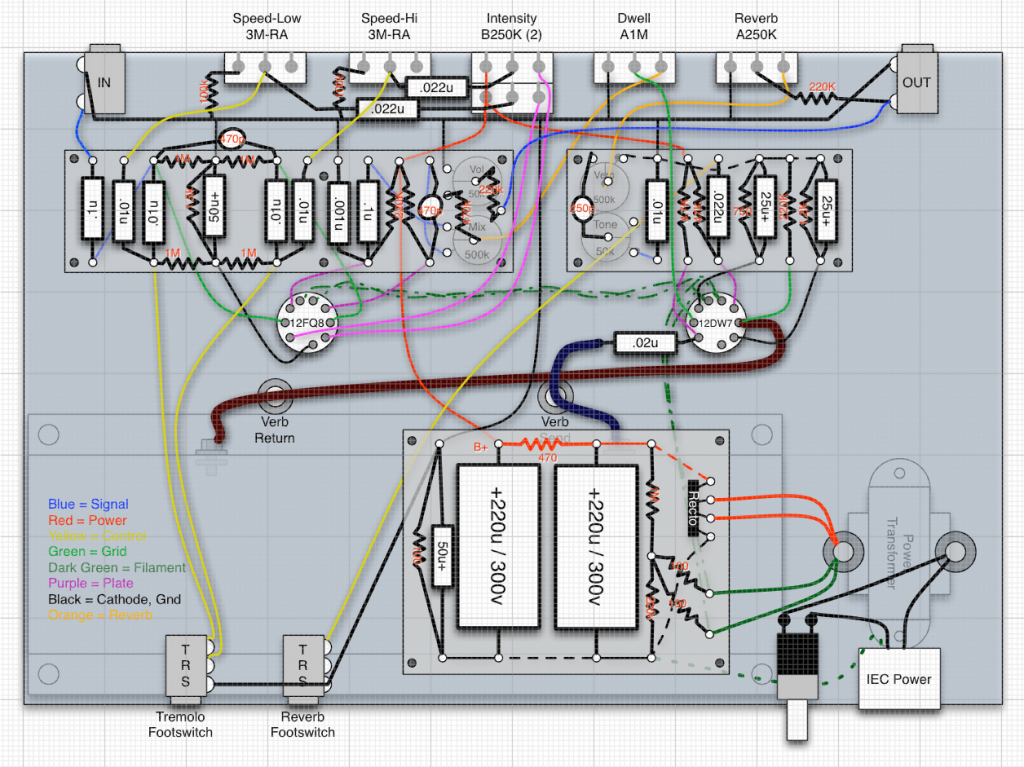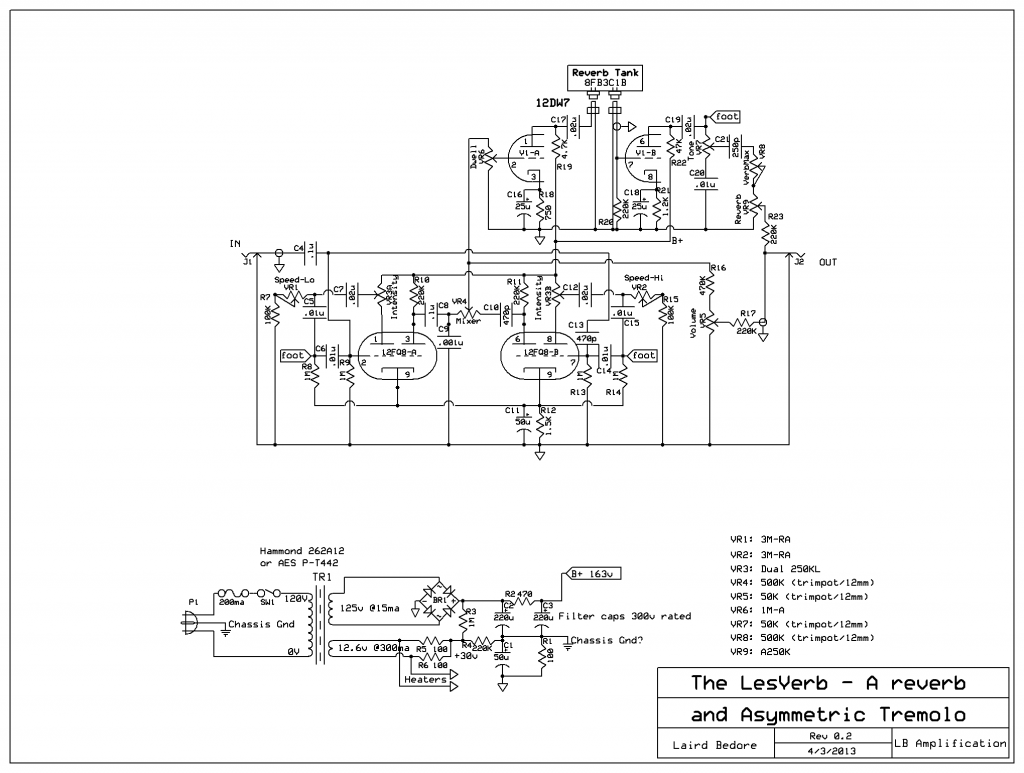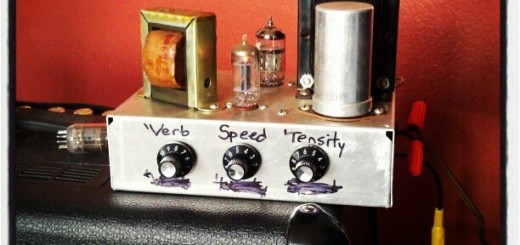Once upon a time a guy on TDPRI pulled a boatload of 12FQ8 tubes from a Wurlitzer organ. They’re pretty odd tubes – Think of it like a 12AX7 with both cathodes tied together, and each triode has not 1, but 2 plates! He graciously sent me a half-dozen to experiment with. This is one of the projects that spawned from my experimentation.
The Idea
There are all sorts of attempts to simulate a Leslie speaker cabinet via effect pedal, but they’re all so ridiculously complex, full of solid-state stuff and digital-sounding. They try to simulate so many factors at once – amplitude modulation, doppler effect, motor acceleration, room-dependent phase shift… it’s no wonder they cost hundreds of dollars and still lack that “feel”. There are better ways in recording and live situations to accommodate room dynamics and physical simulations. I wanted to build something that simply modulates the high and low frequencies at different speeds.
A few years ago I built a “Weber” (really Gehring) ReVibe, which after a lot of tweaking I mostly love. It seemed to me there had to be a way to build one cheaper and simpler. And do the Leslie thing at the same time. Hence the birth of the LesVerb!
The Details
The idea is straightforward – Split the input signal into a high and low band and send them to separate triodes for amplification. Here’s where the 12FQ8′s magic comes into play: each triode has a second plate that drives itself as a phase-shift oscillator with its own speed control. The two outputs are mixed together before being sent off to reverb.
To provide stable intensity control, the intensity pot serves as the (fixed) plate load, and when wired backwards the wiper serves as a voltage divider that pushes a controllable portion of the signal into the oscillator feedback loop. The fixed plate load also ensures that the operating range of the stage remains constant whether the trem is on or off.
For reverb I initially planned on using a 6BM8/ECL82, letting the pentode drive a transformer-coupled reverb tank and recover with the triode side. But there was a problem – the 6BM8′s filament is 6.3v only and the 12FQ8′s is 12.6v only. I tried to find transformers with suitable secondaries, or at least a center-tapped 12.6v filament, but there were no reasonable options. I then searched for a practical alternative to the 6BM8 with a 12.6v filament, but the only options I found were very obscure 12-pin compactrons. I had to find another solution using a 12v-filament tube.
Transformerless capacitor-coupled reverb… It’s been done by Univox and a few others, Merlin suggests it on his reverb drivers page… Sure, why not? Univox did it with a single 12AT7, but many accounts I found online recommended driving with both triodes in parallel, or better yet, using a 12AU7. Another side-effect of the direct coupling is that the impedance mismatch would cause greater signal loss through the tank – ideally I would want to use a 12AX7 triode for recovery. AH HAH! A perfect use case for the often-ignored 12DW7! The low-mu “12AU7″-like side would drive the tank as hard as it could, and the high-mu “12AX7″-like side would do the recovery.
The Economics
The Jeff Gehring ReVibe is a BEAST to build. It’s available as a kit from Weber for $500 – an awful lot of money for an effect. This LesVerb costs just over $200 after tax and shipping. How is that possible? Two fewer transformers, three fewer tubes, and about 30 fewer caps and resistors. The reverb tank is directly mounted to the chassis, eliminating the need for a cabinet. Simplicity is a good thing.
The following quality components are used, to provide maximum quality for the money:
- Filter Caps – F&T
- Cathode Bypass Caps – Vishay/BC and Nichichon
- Signal caps – Mallory 150s, Xicon ceramics
- Tubes – NOS GE 12FQ8 and 12DW7
- Tube Sockets – Belton
- Chassis – Hammond
- Switches – Carling
- Jacks – Neutrik
- Pots – CTS and Alpha
- Trimpots: Piher radial
- Resistors – Xicon
The BOM is available at the bottom of the page. It includes everything but wire and chassis decoration. It includes different color knobs to help tell the controls apart. Of course you’ll need to provide your own drill, screwdrivers, soldering iron, etc. An eyelet staking tool is even included in case you need one.
There is just one item I would consider upgrading – the “MOD” brand reverb tank. It’s the only “F”-class tank available at AES. A proper Accutronics 8FB(2C1B) tank would most certainly provide better-sounding reverb, but I would advise against using an 8EB-type tank… the lower input impedance will reduce the volume and frequency response.
Building It
I designed the layout using three discrete boards – one for trem, one for reverb, and one for power. In an effort to simplify the build and avoid a costly cabinet, I opted to mount the reverb tank directly to the top of the chassis with rubber grommets as shock absorbers and insulators. All of this fits neatly in a 12x8x2 chassis, a standard size made by Hammond.
A few random notes:
- The “low-frequency” triode actually amplifies the entire input signal, but the high-end is passed to ground at the output. The .1uf (C8) coupling cap may need to be adjusted to reduce the amount of subsonic oscillation signal making its way to the reverb and the output. If it gets real crazy, a 2nd-order HPF might be necessary like I did on the 6T9 ReVibe.
- The value of the .001u LPF shunt cap has a relationship to the 470pf input and output caps on the “high-frequency” triode – put these values too close together and you end up with a hump in the midrange, put them too far apart and you get a scoop.
- The total gain of this circuit is going to be high, probably around 50. The internal trimpots serve to tune the output volume for roughly unity gain.
- I wanted to use LEDs to bias the 12FQ8 and high-mu side of the 12DW7, but with the low B+ my ideal bias point was 1.0v and I couldn’t find any LEDs that would “land” there. Most of them would land around 1.5v, which is WAY past the linear sweet spot when using this low of a B+. I could LED bias the reverb driver since its ideal bias point is at 4v, but that stage wouldn’t really benefit from it.





